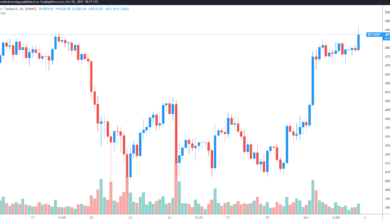
Bitcoin Price Prediction Next 5 Years Comprehensive Analysis and Expert Forecasts for 2025-2029
The cryptocurrency market continues to evolve at a rapid pace, with Bitcoin leading the charge as the world’s premier digital asset. Investors, traders, and financial institutions worldwide are eagerly seeking a reliable Bitcoin price prediction next 5 years to guide their investment strategies. Understanding Bitcoin’s potential trajectory through 2025-2029 has become crucial for anyone looking to capitalize on the cryptocurrency revolution.
As we navigate through an era of institutional adoption, regulatory developments, and technological advancements, the question on everyone’s mind remains: where will Bitcoin’s price be in the next five years? This comprehensive analysis examines expert forecasts, market dynamics, and fundamental factors that will shape Bitcoin’s value through 2029. Our Bitcoin price prediction next 5 years assessment considers multiple variables, including halving cycles, market maturation, global economic conditions, and emerging trends that could significantly impact BTC’s future valuation.
Current Bitcoin Market Landscape and Price Drivers
Bitcoin’s current market position provides the foundation for any meaningful long-term prediction. As of 2025, several key factors are influencing Bitcoin’s price trajectory and will continue to play crucial roles in the coming years.
The cryptocurrency has evolved from a speculative digital asset to a recognized store of value, with institutional investors increasingly viewing Bitcoin as “digital gold.” Major corporations like Tesla, MicroStrategy, and Square have added Bitcoin to their treasury reserves, while traditional financial institutions offer Bitcoin-related products and services.
Market dynamics have shifted significantly since Bitcoin’s early days. The introduction of Bitcoin ETFs has provided mainstream investors with regulated access to cryptocurrency exposure, leading to increased institutional adoption and price stability. This institutional interest creates a more mature market environment that reduces extreme volatility while potentially limiting explosive upward movements.
Regulatory clarity continues to emerge globally, with many countries establishing frameworks for cryptocurrency operations. The United States, European Union, and other major economies are developing comprehensive regulations that provide certainty for institutional investors while protecting consumers.
Bitcoin Price Prediction Next 5 Years 2025 Market Outlook
The year 2025 represents a critical juncture for Bitcoin’s price development. Current market analysis suggests Bitcoin could reach $200,000 by 2025, with some forecasts from major financial institutions like Citi predicting prices as high as $199,000 by year-end.
Several factors support bullish Bitcoin predictions for 2025. The ongoing institutional adoption continues to drive demand, while the fixed supply of 21 million Bitcoin creates natural scarcity. Additionally, global economic uncertainty and inflation concerns push investors toward alternative stores of value, benefiting Bitcoin’s long-term prospects.
The ETF inflows have created sustained buying pressure, providing a steady stream of institutional capital entering the Bitcoin market. This institutional backing offers price support during market downturns while contributing to long-term appreciation.
However, regulatory uncertainties remain a potential headwind. Changes in government policies, taxation frameworks, or restrictions on cryptocurrency trading could impact Bitcoin’s price trajectory throughout 2025.
Technical analysis suggests Bitcoin may experience periods of consolidation before reaching new all-time highs. The cryptocurrency’s historical patterns indicate that significant price movements often occur in waves, with periods of accumulation followed by rapid appreciation.
2026-2027 Bitcoin Price Forecasts and Market Evolution
Looking ahead to 2026 and 2027, the Bitcoin price prediction next 5 years suggests continued growth with increasing market maturation. Industry experts indicate that Bitcoin will see an “up year” in 2026, with the traditional four-year cycle potentially becoming less relevant.
Conservative forecasts for 2026 suggest Bitcoin could trade between $99,910 and $200,000, with potential to exceed $200,000 in optimistic scenarios. This wide range reflects the inherent uncertainty in cryptocurrency markets while acknowledging Bitcoin’s significant upside potential.
The 2026-2027 period may witness several important developments. Central bank digital currencies (CBDCs) will likely become more prevalent, potentially affecting Bitcoin’s role as a digital currency alternative. However, Bitcoin’s decentralized nature and limited supply may benefit from CBDC implementations, as investors seek alternatives to government-controlled digital currencies.
Market infrastructure will continue to develop during this period. Improved custody solutions, more sophisticated trading platforms, and enhanced security measures will make Bitcoin more accessible to traditional investors. These developments typically support higher valuations by reducing investment barriers and increasing market confidence.
Corporate treasury adoption may accelerate during 2026-2027 as more companies recognize Bitcoin’s potential as an inflation hedge and portfolio diversifier. This corporate adoption could provide sustained demand pressure, supporting higher price levels.
The 2028 Bitcoin Halving Impact on Price Predictions

The 2028 Bitcoin halving represents one of the most significant catalysts for the Bitcoin price prediction next 5 years analysis. The next Bitcoin halving, expected around April 2028, will see the block reward for miners drop from 3.125 BTC to 1.5625 BTC.
Historical halving events have consistently preceded major bull markets. The reduction in new Bitcoin supply entering the market creates supply-demand imbalances that typically result in significant price appreciation. However, some analysts predict that while prices could reach between $150,000 and $300,000 after the 2028 halving, each halving’s impact appears to be diminishing.
The diminishing halving impact occurs because, as of now, 94.5% of Bitcoin’s total supply has already been mined, and by the time of the next halving in 2028, nearly 97% of all Bitcoin will be in circulation. This means the relative impact of reduced new supply becomes smaller with each halving event.
Nevertheless, the 2028 halving will likely generate significant market attention and speculation. Historical patterns suggest increased volatility in the months leading up to and following halving events, creating opportunities for both gains and losses.
Miners’ economics will change significantly after the 2028 halving. With reduced block rewards, only the most efficient mining operations will remain profitable, potentially leading to mining industry consolidation. This consolidation could impact Bitcoin’s network security and decentralization, factors that may influence long-term price predictions.
2029 Bitcoin Price Outlook and Long-term Projections
As we look toward 2029, Bitcoin price prediction next 5 years becomes increasingly speculative due to the numerous variables that could influence cryptocurrency markets. However, several trends and factors provide insight into potential price ranges.
Following the bullish trend expected in previous years, 2029 is forecasted to continue this momentum, with Bitcoin’s value potentially increasing significantly. The post-halving period historically sees the most dramatic price movements, suggesting 2029 could witness Bitcoin reaching new all-time highs.
By 2029, Bitcoin’s market capitalization could rival or exceed that of gold, particularly if institutional adoption continues at current rates. This “digital gold” narrative becomes more compelling as Bitcoin’s supply becomes increasingly scarce and its market infrastructure matures.
The regulatory environment by 2029 should be significantly clearer, with most major economies having established comprehensive cryptocurrency frameworks. This regulatory clarity typically reduces market uncertainty and supports higher valuations by encouraging institutional participation.
Technological developments over the next five years will also impact Bitcoin’s utility and value proposition. Layer 2 solutions like the Lightning Network will likely become more sophisticated, improving Bitcoin’s scalability and transaction efficiency. These improvements could expand Bitcoin’s use cases beyond store of value to include more practical payment applications.
Global economic conditions in 2029 will significantly influence Bitcoin’s price. If traditional monetary systems face continued challenges from inflation, debt crises, or currency debasements, Bitcoin’s value proposition as a neutral, scarce asset becomes more attractive.
Factors Influencing Long-term Bitcoin Price Predictions
Institutional Adoption and Market Maturation
Institutional adoption remains the primary driver for sustained Bitcoin price growth. As more corporations, investment funds, and financial institutions allocate capital to Bitcoin, the available supply for retail investors decreases, creating upward price pressure.
The development of Bitcoin financial products continues to expand. Beyond ETFs, we’re seeing the emergence of Bitcoin derivatives, structured products, and lending services that increase Bitcoin’s utility in traditional finance.
Regulatory Developments and Government Policies
Regulatory clarity significantly impacts Bitcoin’s long-term price trajectory. Favorable regulations encourage institutional participation, while restrictive policies can limit market growth. The next five years will likely see most major economies establishing clear cryptocurrency regulations.
Government adoption of Bitcoin as a reserve asset, following El Salvador’s example, could dramatically impact global demand. Even small allocations by major economies could absorb significant portions of Bitcoin’s available supply.
Technological Advancements and Network Improvements
Bitcoin’s underlying technology continues evolving. Improvements in scalability, security, and energy efficiency enhance Bitcoin’s value proposition and utility. The Lightning Network and other Layer 2 solutions are making Bitcoin more practical for everyday transactions. Mining technology advances and the transition to renewable energy sources address environmental concerns that have historically impacted Bitcoin’s public perception and institutional adoption.
Global Economic Conditions and Monetary Policy
Bitcoin’s performance often correlates with global economic uncertainty. Expansionary monetary policies, currency debasements, and inflation concerns drive investors toward alternative stores of value like Bitcoin. The next five years may see significant changes in global monetary systems, including the introduction of central bank digital currencies and potential reforms to the international monetary system. These changes could significantly impact Bitcoin’s role in the global financial ecosystem.
Risk Factors and Potential Challenges
Market Volatility and Price Corrections
Despite long-term bullish predictions, Bitcoin will likely experience significant volatility over the next five years. Major corrections of 50-80% from peak prices have historically occurred and should be expected in future market cycles.
Leveraged trading and derivatives markets can amplify Bitcoin’s volatility, creating rapid price movements that may not reflect fundamental value changes. Investors should prepare for significant short-term price swings regardless of long-term trends.
Regulatory Risks and Government Intervention
While regulatory clarity generally benefits Bitcoin, there’s always a risk of restrictive policies or outright bans by major economies. Such actions could significantly impact Bitcoin’s price and adoption trajectory.
Taxation policies for cryptocurrencies continue evolving, and unfavorable tax treatments could reduce investment attractiveness in some jurisdictions.
Technological and Security Risks
Although Bitcoin’s network has operated securely for over a decade, technological risks remain. Quantum computing advances could potentially threaten Bitcoin’s cryptographic security, though the timeline for such threats remains uncertain.
Network governance issues and potential splits in the Bitcoin community could impact price and adoption. While Bitcoin has successfully navigated such challenges before, future disagreements could create uncertainty.
Competition from Other Cryptocurrencies
While Bitcoin maintains its position as the leading cryptocurrency, competition from other digital assets continues to evolve. Central bank digital currencies, improved altcoins, or entirely new technologies could potentially challenge Bitcoin’s market dominance.
Expert Analysis and Market Sentiment
Leading cryptocurrency analysts and financial institutions provide varying perspectives on Bitcoin’s five-year outlook. Henrik Andersson, chief investment officer at Apollo Crypto, predicts a peak price of around $200,000 per Bitcoin before 2028, representing a more conservative but still highly bullish outlook.
Traditional financial institutions are increasingly incorporating Bitcoin into their long-term forecasts. Major investment banks, asset managers, and financial advisory firms are developing Bitcoin price models and recommending portfolio allocations to clients.
The emergence of Bitcoin as a macro asset class has led to its inclusion in broader economic and market analysis. Bitcoin’s correlation with traditional assets during different market conditions provides insights into its role as both a risk asset and safe haven.
Market sentiment indicators, including on-chain analysis, social media sentiment, and institutional flows, provide real-time insights into Bitcoin’s price trajectory. These metrics have become increasingly sophisticated and reliable for understanding market dynamics.
Investment Strategies for the Next Five Years

Dollar-Cost Averaging and Long-term Accumulation
Given Bitcoin’s historical volatility and long-term appreciation trend, dollar-cost averaging remains a popular strategy for investors seeking exposure to Bitcoin’s potential upside while managing short-term volatility risks. Regular accumulation strategies allow investors to benefit from Bitcoin’s appreciation while avoiding the challenges of timing market entries and exits. This approach has historically outperformed most active trading strategies.
Portfolio Allocation and Risk Management
Financial advisors increasingly recommend small Bitcoin allocations (1-5% of total portfolio) as a hedge against traditional market risks and monetary debasement. This allocation provides upside exposure while limiting downside risk to manageable levels. Risk management becomes crucial when investing in volatile assets like Bitcoin. Setting clear investment goals, time horizons, and exit strategies helps investors navigate Bitcoin’s price fluctuations over the next five years.
Institutional Investment Vehicles
The expanding ecosystem of Bitcoin investment products provides various ways to gain exposure to Bitcoin’s price movements. ETFs, futures, and structured products offer different risk-return profiles suitable for various investor types.
Custody solutions have improved significantly, with institutional-grade security and insurance becoming standard. These improvements reduce investment barriers and increase confidence in Bitcoin as a legitimate asset class.
Investment Considerations and Risk Warnings
Investing in Bitcoin involves substantial risks that all potential investors must understand. Bitcoin’s price can experience extreme volatility, with potential losses of 50% or more in short periods. Past performance does not guarantee future results, and Bitcoin price prediction next 5 years should be viewed as educated speculation rather than investment advice.
Regulatory changes could significantly impact Bitcoin’s legal status and price in various jurisdictions. Investors should stay informed about regulatory developments in their regions and consider the potential impact of policy changes on their Bitcoin holdings.
The cryptocurrency market remains relatively immature compared to traditional financial markets. This immaturity can lead to price manipulation, a lack of liquidity during stress periods, and technical issues that could affect Bitcoin’s price and accessibility. Investors should only allocate capital they can afford to lose entirely to Bitcoin investments. The cryptocurrency’s experimental nature and regulatory uncertainties create risks that traditional assets don’t face.
Technical Analysis and Price Patterns
Bitcoin’s price history reveals patterns that may provide insights into future movements. The cryptocurrency typically experiences four-year cycles coinciding with halving events, though these patterns may become less pronounced as the market matures.
Support and resistance levels, based on historical trading data, suggest key price points that may influence Bitcoin’s trajectory over the next five years. However, technical analysis becomes less reliable over longer time horizons, particularly in volatile markets like cryptocurrency.
On-chain analysis provides additional insights into Bitcoin’s network health and investor behavior. Metrics like active addresses, transaction volume, and long-term holder behavior can indicate market trends and potential price movements. The development of more sophisticated trading infrastructure, including derivatives markets and institutional trading platforms, may impact Bitcoin’s price patterns and volatility characteristics over the next five years.
Global Economic Impact and Bitcoin’s Role
Bitcoin’s role in the global financial system continues evolving. As traditional monetary systems face challenges from inflation, debt, and currency instability, Bitcoin’s value proposition as a neutral, scarce asset becomes more compelling. The potential adoption of Bitcoin as a reserve asset by corporations and governments could dramatically impact its price trajectory. Even small allocations by major entities could absorb significant portions of Bitcoin’s available supply.
Central bank digital currencies (CBDCs) may paradoxically benefit Bitcoin by highlighting the differences between government-controlled digital currencies and decentralized alternatives. This contrast could drive demand for Bitcoin as a truly independent digital asset. International sanctions and currency restrictions may increase Bitcoin adoption in affected regions, creating additional demand sources that could support higher prices over the next five years.
Also Read: Bitcoin price Poised for $150,000: Key Drivers Behind Upcoming Crypto.
Conclusion
The Bitcoin price prediction next 5 years presents a compelling case for significant appreciation, with expert forecasts ranging from conservative estimates of $150,000 to optimistic projections exceeding $300,000 by 2029. Multiple factors support these bullish outlooks, including institutional adoption, regulatory clarity, supply scarcity, and the upcoming 2028 halving event.
However, investors must recognize the substantial risks and volatility associated with Bitcoin investments. The cryptocurrency’s price journey over the next five years will likely include significant corrections alongside periods of rapid appreciation. Success in Bitcoin investing requires patience, risk management, and a thorough understanding of the factors driving its long-term value.







